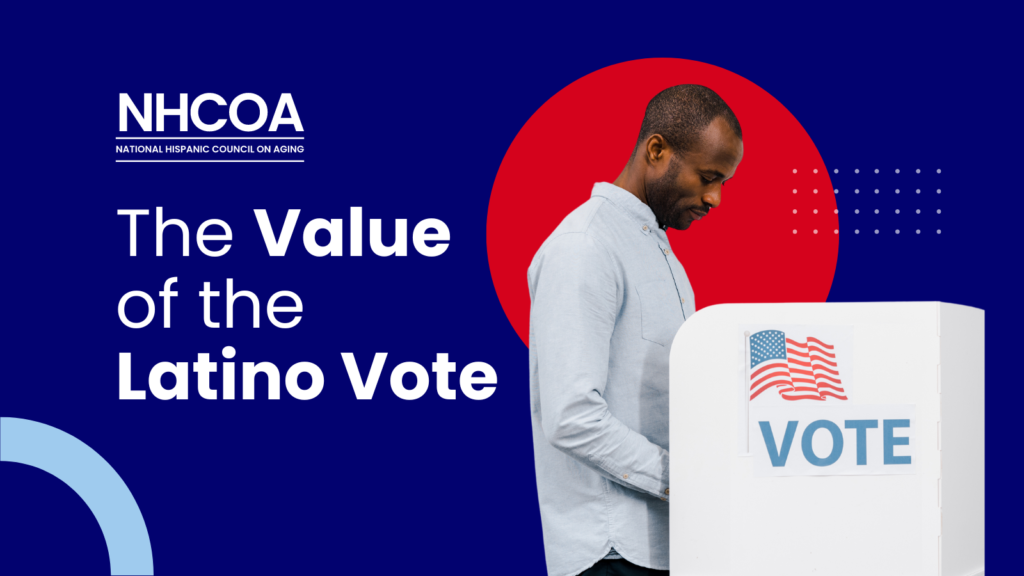
Ahead of the incoming election, the National Hispanic Council on Aging wants to remind Latino communities across the country of the incredible value their voices have on the future of the United States. As one of the largest and fastest growing demographics in the country, it should come as no surprise that eligible Latino voters can have an immense sway on elections. In the past, voter turnout has often accounted for less than half of eligible Latino voters. However recent years show a significant uptick.
In 2016, 27.3 million Latinos were eligible, and only about 12.7 million ended up casting their vote. Compare that to the 2020 election, where almost 30 million Latinos were eligible to vote, and 16.5 million ended up doing so. In the time between 2016 and 2020, the number of eligible Latino voters increased by almost 10%, and the number of those who voted increased by almost 30%. Not only does this mark a significant increase in voter turnout, it specifically marks that over half (54%) of eligible Latinos voters participated in the 2020 election.
So how does this fit in with expectations for the 2024 election?
The Pew Research Center projects that the total amount of eligible Latino voters will have increased to 36.2 million this year. This projection also implies that Latinos will account for 14.7% of all total eligible voters in 2024. Of course, these figures represent the total Latino population across the country and so we also have to look at the statistics state by state.
In 38 states, Latinos account for less than 10% of eligible voters. The remaining 12 states are as follows, in order of largest portion of eligible voters to least:
| 1. New Mexico: 45% | 7. Colorado: 17% |
| 2. California: 33% | 8. New Jersey: 16% |
| 3. Texas: 32% | 9. New York: 15% |
| 4. Arizona: 25% | 10. Connecticut: 14% |
| 5. Nevada: 22% | 11. Illinois: 13% |
| 6. Florida: 22% | 12. Rhode Island: 12% |
In New Mexico, California, and Texas, the Latino vote will prove to be a massive influence, and will subsequently have a large impact on the electoral college.
What does the population of eligible Latino voters look like today?
In the 2020 election, where we saw 54% of eligible Latino voters participate, the majority of Latino voters were women. Of the total eligible Latina voters, about half made their way to the polls, whereas Latino men only saw a turnout of 45%.
A striking majority of current eligible Latino voters are from younger generations. Latinos ages 50 years and older account for about 33% (or one third) of the total. Specifically, the age demographics are as follows:
- 30 to 49 years old: 37%
- 18 to 29 years old: 31%
- 50 to 64 years old: 20%
- +65 years old: 13%
This means that the majority of eligible Latino voters in 2024 are millennials, while a growing number of Gen Z voters follow, making Latino American youth a powerful force among voter demographics. Come this November, the National Hispanic Council on Aging wants to encourage everyone to get out to the polls and cast your vote. Your voices are important, and absolutely must be heard and accounted for in the planning of the future of the United States.
References:
- Krogstad, Jens Manuel et all. “Key facts about Hispanic eligible voters in 2024,” Pew Research Center. https://www.pewresearch.org/short-reads/2024/01/10/key-facts-about-hispanic-eligible-voters-in-2024/
- Krogstad, Jens Manuel et all. “Key facts about the Latino vote in 2016,” Pew Research Center. https://www.pewresearch.org/short-reads/2016/10/14/key-facts-about-the-latino-vote-in-2016/
- “¡PRESENTE!: Latino Voters,” National Museum of the American Latino. https://latino.si.edu/exhibitions/presente/shaping-nation/latino-voters

Recent Comments